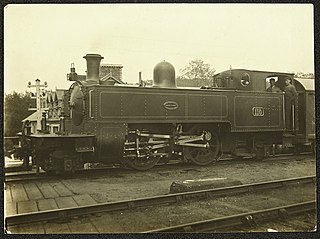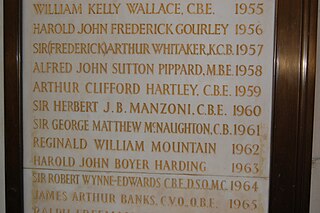Related Research Articles

The London, Midland and Scottish Railway (LMS) was a British railway company. It was formed on 1 January 1923 under the Railways Act of 1921, which required the grouping of over 120 separate railways into four. The companies merged into the LMS included the London and North Western Railway, the Midland Railway, the Lancashire and Yorkshire Railway, several Scottish railway companies, and numerous other, smaller ventures.
Sir William Arthur Stanier, was a British railway engineer, and was chief mechanical engineer of the London, Midland and Scottish Railway.
The London, Midland and Scottish Railway had the largest stock of steam locomotives of any of the 'Big Four' Grouping, i.e. pre-Nationalisation railway companies in the UK. Despite early troubles arising from factions within the new company, the LMS went on to build some very successful designs; many lasted until the end of steam traction on British Railways in 1968. For an explanation of numbering and classification, see British Rail locomotive and multiple unit numbering and classification.
Sir Henry Fowler, was an English railway engineer, and was chief mechanical engineer of the Midland Railway and subsequently the London, Midland and Scottish Railway.
Charles Edward Fairburn was an English electrical engineer whose work mainly concerned rail transport.
Sir Ernest John Hutchings Lemon was an English railway engineer, and was chief mechanical engineer of the London, Midland and Scottish Railway and later one of its three Vice-Presidents. During the run-up to the Second World War, Lemon was made Director-General of Aircraft Production and made crucial improvements to aircraft production.
Robert Arthur "Robin" Riddles, CBE, MIMechE, MinstLE was a British locomotive engineer.

The Northern Counties Committee (NCC) was a railway that served the north-east of Ireland. It was built to Irish gauge but later acquired a number of 914 mm narrow gauge lines. It had its origins in the Belfast and Ballymena Railway that opened to traffic on 11 April 1848.

The NCC Class WT is a class of 2-6-4T steam locomotives built by the Northern Counties Committee's parent company, the London, Midland and Scottish Railway for service in Northern Ireland.
The LMS Northern Counties Committee (NCC) Class Y was a class of 0-6-0T steam locomotives formed when two LMS Fowler Class 3F engines were regauged from 4 ft 8+1⁄2 instandard gauge to the 5 ft 3 in Irish broad gauge in 1944 becoming NCC Nos.18 and 19.
The Belfast and Northern Counties Railway (BNCR) Class A was a class of 13 two-cylinder compound steam locomotives built for service in north-east Ireland. The first two members of the class would be the last locomotives to be built for the independent BNCR, being completed before its purchase by the Midland Railway in 1903. The members of the class were rebuilt by the LMS (NCC) becoming either Class A1 or Class U2 depending on how they had been modified.

The Northern Counties Committee (NCC) Class U2 4-4-0 passenger steam locomotives consisted of 18 locomotives built for service in north-east Ireland. Ten of the engines were new builds supplied by the North British Locomotive Company (NBL) or constructed at the NCC's York Road works. The remainder were rebuilds of existing locomotives.

The Belfast and Northern Counties Railway (BNCR) Class S was a class of 2-4-2T two-cylinder compound steam locomotives that was introduced for service on the 3 ft narrow gauge railways of County Antrim in north-east Ireland.
The history of rail transport in Great Britain 1923–1947 covers the period when the British railway system was run by the Big Four group of companies – the London, Midland and Scottish Railway (LMS); the Great Western Railway (GWR); the London and North Eastern Railway (LNER); and the Southern Railway (SR). The period includes the investment following World War I; the rise in competition from the roads in the 1920s; development of steam locomotives capable of sustained 100 mph (160 km/h) running; the Great Depression of the 1930s; World War II and its aftermath; and the lead up to nationalisation during 1947.
The "Big Four" was a name used to describe the four largest railway companies in the United Kingdom in the period 1923–1947. The name was coined by The Railway Magazine in its issue of February 1923: "The Big Four of the New Railway Era".

William Kelly Wallace (1883–1969) was an Irish railway engineer who joined the Northern Counties Committee and later became Chief Civil Engineer of the London Midland and Scottish Railway (LMS). He was awarded a civil CBE in the 1946 New Year Honours.
The Northern Counties Committee (NCC) Class S1 was a class of two-cylinder compound 2-4-2T steam locomotives that was introduced for service on the 3 ft (914 mm) narrow gauge railways of County Antrim in north-east Ireland. The members of the class were rebuilds of the BNCR Class S.
The LMS (Northern Counties Committee)Class A1 4-4-0 passenger steam locomotives were rebuilds of Belfast and Northern Counties Railway Class A two-cylinder compound locomotives. They operated services throughout the NCC’s 5 ft 3 in (1,600 mm) broad gauge system in the north-east of Ireland.
Carnforth MPD (Motive Power Depot) is a former London Midland and Scottish Railway railway depot located in the town of Carnforth, Lancashire, England.
References
- 1 2 Jones, Kevin P. "Biographies of chairmen, managers & other senior railway officers". SteamIndex. Retrieved 23 March 2009.